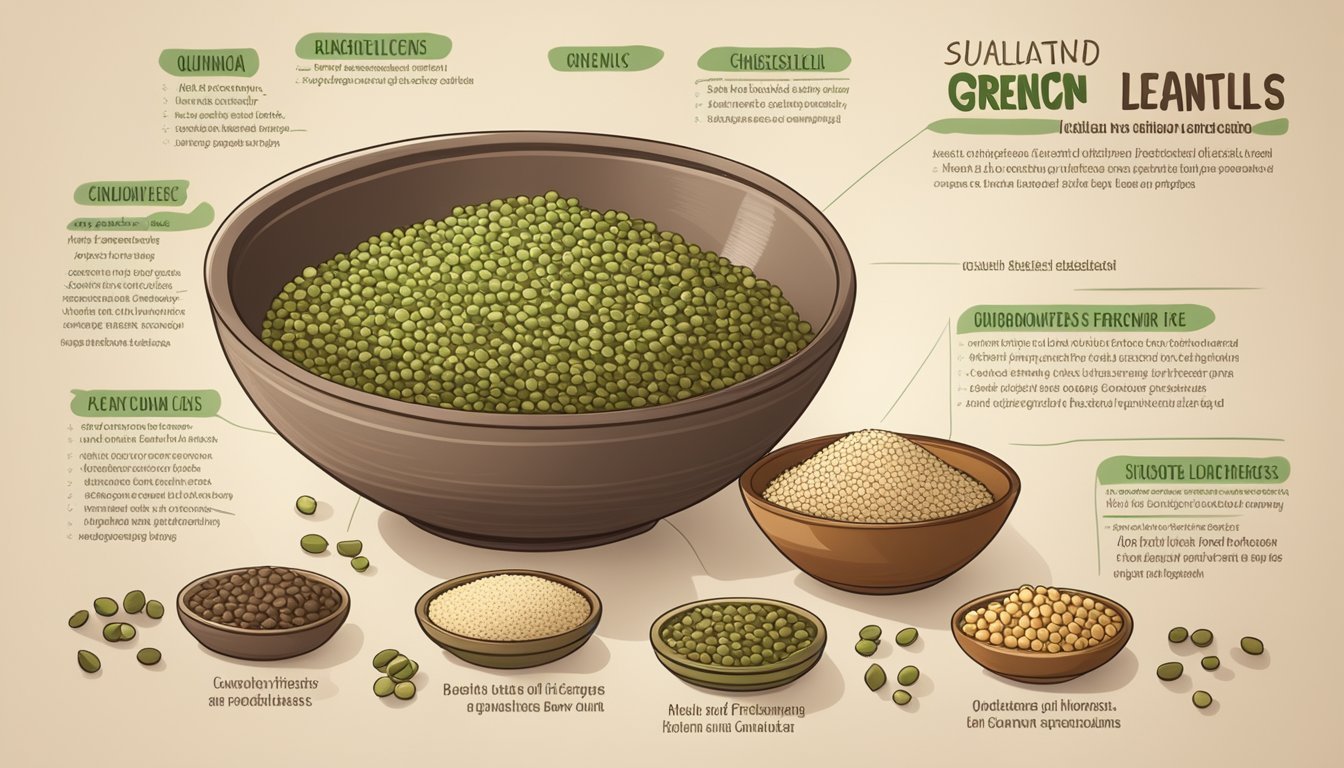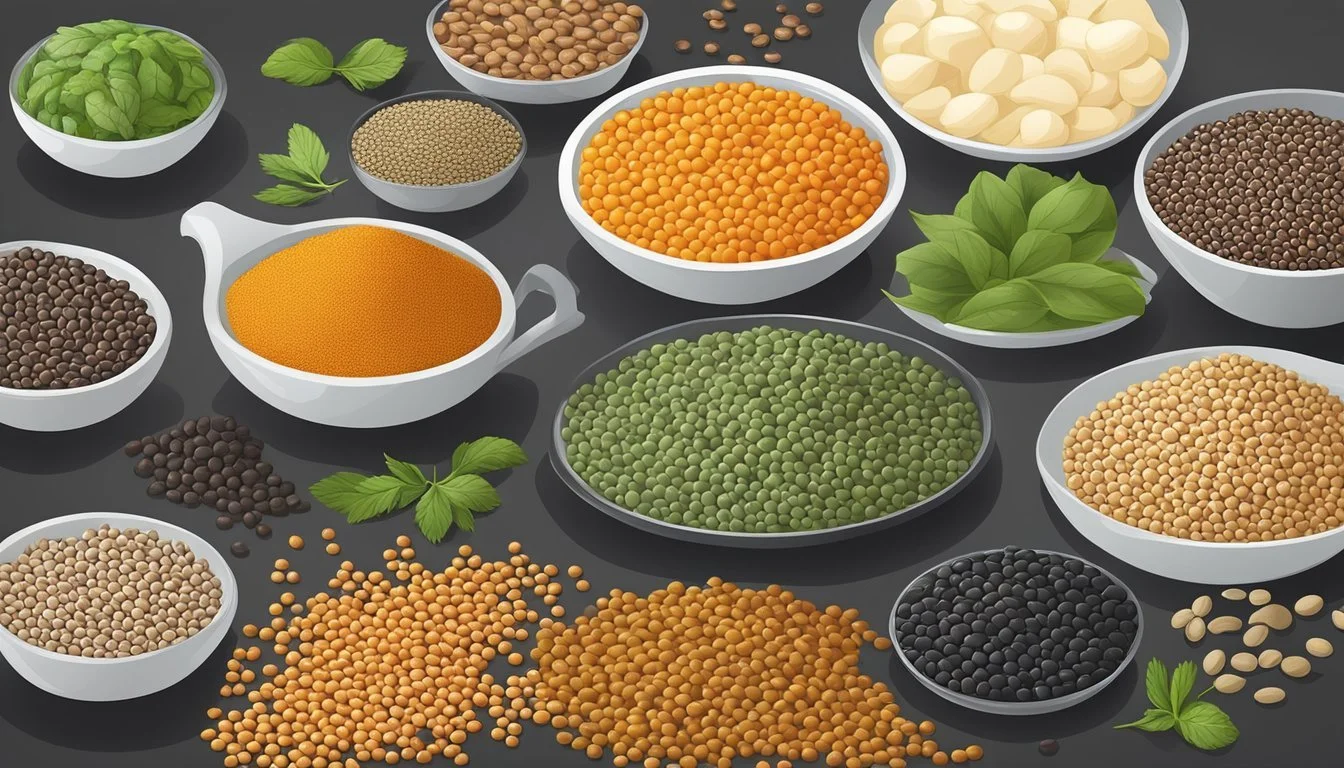French Green Lentils Substitutes
Best Alternatives for Your Recipes
When it comes to finding substitutes for French green lentils, several options stand out for their nutritional value and versatility in cooking. Red beans, garbanzo beans, black beans, and soy are all excellent alternatives that can bring a similar texture and flavor to your recipes. These substitutes not only match the protein and fiber content of French green lentils but also provide a rich, earthy flavor that complements a variety of dishes.
Whether you're looking to create lentil tacos, salads, or hearty stews, these legume alternatives can seamlessly replace French green lentils while maintaining the integrity of your recipes. Peas, chickpeas, and even quinoa are also worth considering as they offer unique textures and nutritional benefits. Each substitute brings its distinct characteristics, making it easy to tailor your dish to suit your taste preferences.
Using substitutes like beans and soy not only diversifies your meals but also ensures that you’re getting a healthy dose of plant-based protein. These ingredients can be used in a 1:1 ratio, though cooking times may vary slightly, so adjustments might be necessary.
Understanding French Green Lentils
French green lentils, also known as Puy lentils, are renowned for their speckled appearance and nutrient density. They offer a rich source of protein and fiber, making them both flavorful and highly nutritious.
Nutritional Profile
French green lentils boast an impressive nutritional profile. They are high in protein, which is essential for muscle repair and growth, making them a great option for vegetarians and vegans. Each serving of French lentils provides a significant amount of fiber, aiding in digestive health.
These lentils are rich in vitamins such as B vitamins, which support energy levels and brain function. They also contain important minerals like iron, magnesium, and zinc, contributing to overall health. With a low glycemic index, they can help manage blood sugar levels effectively.
Culinary Uses
French green lentils have a unique earthy flavor and firm texture. Unlike other lentils, they hold their shape during cooking, which makes them ideal for a variety of dishes. They are frequently used in hearty salads, providing a satisfying bite and flavor contrast to fresh vegetables.
These lentils are also popular in soups and stews, where their firmness adds texture and substance. Their versatility extends to side dishes, where they complement meat or fish, delivering both taste and nutrition. French lentils can even be utilized in vegetarian patties, offering a protein-rich alternative to meat.
Common Substitutes for French Green Lentils
Finding alternatives for French green lentils can be crucial in certain recipes. Key substitutes include other legumes, whole grains, and protein-rich options, each bringing unique textures and nutritional benefits.
Beans and Other Legumes
Beans are versatile and readily available substitutes for French green lentils. Black beans, kidney beans, and chickpeas provide a rich, earthy flavor, though black beans might alter the dish's appearance.
Brown lentils and red lentils are more accessible and cook faster. Puy lentils, although pricier, closely mimic the texture and flavor of French green lentils. Green peas can also be used, offering a softer texture.
Whole Grains
When lentils aren't available, whole grains can step in effectively. Quinoa is a popular option due to its protein content and slightly nutty flavor.
Barley and bulgur wheat are also good choices, adding heartiness and a chewy texture to dishes. Kamut can serve as another substitute, though its preparation time may be longer.
Protein-Rich Alternatives
For those needing protein-rich substitutes, soybeans, tofu, and tempeh work well. Soybeans offer a high protein content and can be used similarly to lentils in stews and soups.
Tofu and tempeh are suitable for vegetarian and vegan diets, providing substantial texture and flavor. Peanuts and quinoa can also be considered, each bringing additional health benefits to the dish.
Optimal Preparation Techniques
When substituting French green lentils, mastering the optimal preparation techniques is essential for achieving the desired texture and flavor in your dishes. Here we discuss the specifics of cooking times, measurements, soaking, and sprouting to get the best results.
Cooking Times and Measurements
Cooking times and measurements vary significantly when substituting French green lentils with other ingredients. Black beans may require a longer cooking time, often taking 45 minutes to an hour. On the other hand, chickpeas might need around 90 minutes.
Quinoa is much faster, usually ready in about 15 minutes. It’s crucial to use a 1:2 ratio of quinoa to water. To replace French green lentils effectively, ensure you monitor the texture of the substitute during cooking; they should be cooked until soft but not mushy.
Ingredient Cooking Time Water Ratio Black Beans 45-60 mins 1:3 Chickpeas 90 mins 1:3 Quinoa 15 mins 1:2 Red Beans 70-90 mins 1:3
Soaking and Sprouting
For some substitutes, soaking is necessary to reduce cooking time and improve digestibility. Black beans and chickpeas benefit greatly from soaking, typically requiring an overnight soak or at least 8-10 hours.
Sprouting can enhance the nutritional profile. Soak the beans for 12 hours, then rinse and drain. Leave them in a jar covered with a cloth, rinsing every 12 hours until tiny sprouts form, usually within 2-3 days.
When soaking kamut or quinoa, a shorter time is sufficient. Soaking them for 2-4 hours before cooking can yield a softer and easier-to-digest grain.
Preparation techniques can vary, but these guidelines ensure that substitutes for French green lentils are prepared to fit seamlessly into your recipes.
Incorporating Substitutes in Recipes
When substituting French green lentils, options like split peas, chickpeas, and red beans can be effectively utilized in various dishes, each bringing unique flavors and textures.
Soups and Stews
Split peas are an excellent stand-in for French green lentils in soups and stews. They offer a similar earthy taste and cook faster, which is useful for quick meals. To substitute, use a 1:1 ratio but monitor cooking times closely due to their softer texture.
Chickpeas are another suitable substitute. Their nutty flavor and creamy texture blend well in hearty dishes. They maintain their shape under prolonged cooking, making them ideal for chunky stews.
In vegan and plant-based recipes, quinoa can provide the nutritional benefits and a texture that mimics lentils, albeit with a slightly different mouthfeel. It absorbs flavors well, enhancing the depth of stews.
Salads and Side Dishes
Red beans, with their slightly sweet taste, work well in lentil salads or as an easy side dish. They retain their firmness, which helps maintain the salad’s texture. Use them in a 1:1 ratio and consider adjusting your dressing to complement their flavor.
Chickpeas can be effortlessly incorporated into side dishes. Their creamy texture and nutty taste can elevate simple salads, providing a protein-rich alternative suitable for vegetarian and vegan meals.
For a more delicate option, try using soybeans. Their smaller size and subtle flavor can blend seamlessly into various salads and sides, offering both protein and a pleasant texture.
Main Courses
In main courses, hearty beans like garbanzo beans and refried beans are perfect substitutes for French green lentils. These beans work particularly well in dishes such as lentil tacos or vegetarian burgers, providing similar texture and protein content.
Soy can also be used to replace lentils in main dishes. It offers a comparable protein boost and can be used in recipes like stir-fries and casseroles. Its versatility allows it to absorb surrounding flavors, making it a great base for various seasonings and sauces.
Kamut, though less common, can serve as an interesting alternative. Its chewy texture and nutty flavor make it suitable for grain-based dishes, adding complexity to lentil recipes without overshadowing other ingredients.
Nutritional Considerations for Substitutes
When substituting French green lentils, it’s essential to compare nutritional factors such as protein content, fiber, vitamins, and minerals. Equally important are dietary restrictions and potential allergens.
Macronutrients and Micronutrients
French green lentils are rich in protein and fiber, making them an excellent choice for those looking to balance their diet with plant-based nutrients. Chickpeas and black beans are notable substitutes, offering high protein levels and substantial fiber content.
Iron and folate are abundant in lentils, aiding in preventing anemia and supporting overall vitality. Substitutes like soybeans and tofu also provide significant amounts of these nutrients.
Manganese and potassium are other critical minerals found in lentils. Quinoa and garbanzo beans are excellent alternatives that supply these minerals, contributing to diabetes management and heart health. Generally, these substitutes maintain a profile low in fat while being nutrient-dense.
Dietary Restrictions and Allergies
For those with dietary restrictions, it’s crucial to consider which substitutes meet specific needs. Many lentil substitutes, such as tofu and quinoa, are naturally gluten-free and suitable for individuals with celiac disease or gluten sensitivity.
Soybeans can serve as a reliable option for those avoiding animal products, being a strong source of plant-based protein. Substitutes such as pinto beans and chickpeas are both dairy-free and low in calories, making them suitable for various dietary plans, including vegan and weight-loss diets.
Allergen-wise, it’s important to be cautious with substitutes like peanuts for anyone with nut allergies. Conversely, black beans and cannellini beans generally pose a lower risk of allergic reactions.
These considerations ensure that even while substituting, one maintains a balanced and safe nutritional intake.
Exploring Global Cuisine with Substitutes
Using substitutes for French green lentils (lentilles du Puy) opens doors to diverse culinary traditions, allowing a variety of substitutions to bring new flavors and textures to traditional dishes.
Regional Dishes and Variations
In regions like India, where lentils are a staple, substituting lentilles du Puy with local varieties offers interesting results. Red lentils (masoor dal), despite their distinct texture, can bring a unique, peppery flavor to Indian dishes. Black beans are another excellent substitute for French lentils in Latin American recipes. With their rich, earthy flavor, they transform traditional dishes like Mexican enchiladas or Cuban black bean soup.
In Italian cuisine, chickpeas can replace lentilles du Puy in recipes like stews and pasta dishes, providing a creamy consistency and subtle flavor. White beans work well in Mediterranean dishes, especially in soups and cassoulets, offering a similar texture and taste profile.
Fusion and Experimental Cooking
Substitutes for French green lentils shine in fusion and experimental cooking. Tofu can bring a mild flavor and meaty texture to Asian-inspired dishes like stir-fries and curries. Quinoa, due to its nutty flavor and protein content, fits well in salads and grain bowls, adding texture and nutritional value.
Using kamut in place of lentils in Middle Eastern dishes can create a chewy, flavorful alternative. Experimenting with peanuts in African-inspired stews and casseroles introduces a rich, nutty taste. These substitutes allow for innovation in the kitchen, letting cooks explore global recipes while maintaining nutritional benefits.






